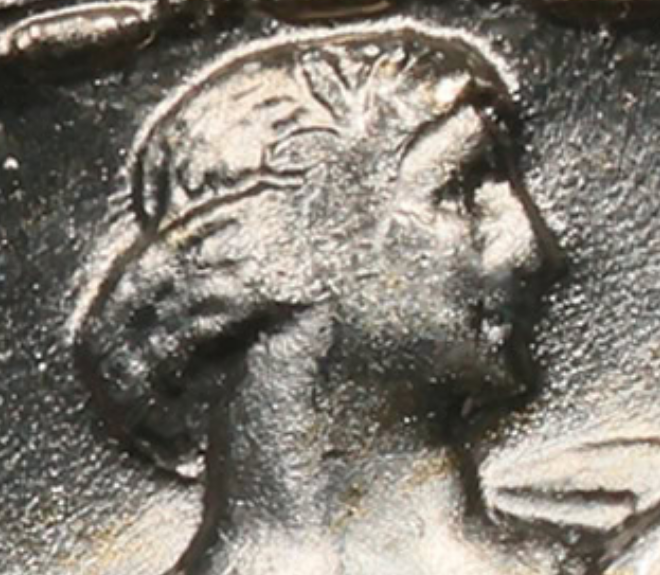SLQ Full Head Designation Questions
 Matt04
Posts: 318 ✭✭✭
Matt04
Posts: 318 ✭✭✭
The other day I began diving into research to get a better understanding on the FH designation for SLQ's. I really love the design and would like to begin collecting them. An important thing I'd like to better understand is the FH designation and how to understand what gets it and what doesn't. What key points are tell tale signs of one not considered a FH designation? Are their areas/details you attempt to spot the know whether or not its a FH? A very weak strike is obvious but then it gets abit harder. An additional spot to look at is the shield and its rivets for a good strike, but it seems to be common for it to not be fully struck and I have seen that occur on FH's as well. I'd love to hear input and how you learned or know how to decipher for SLQ FH's.
Below I attached an image of a quarter I found online, would this be considered a FH? If yes or no why? Thank you

Comments
Not a full head.
Type II Standing Liberty Quarters receive the Full Head designation when the helmet exhibits three complete and distinct leaves, a complete outline on the bottom of the helmet, and a clear ear hole on Miss Liberty’s head.
Not a full head. The hair, face and leaves are good but with softness or flatness or incompleteness over the ear with no distinct ear hole. Still a nice T2.
Sometimes, it’s better to be LUCKY than good. 🍀 🍺👍
My Full Walker Registry Set (1916-1947):
https://www.ngccoin.com/registry/competitive-sets/16292/
FH, despite the non-FH call by PCGS. More recently submitted FH 1929-S quarters have had similar weakness, indicating what is written in the standard is not what is being applied. The gunk on the right upper reverse is more of a concern to me than if the coin is FH.
Edit: example below of a PCGS/CAC 1929-S FH.

And another:

They can also receive the Full Head designation when the published standards aren’t adhered to. I’ve seen a lot of examples designated “FH” that were deficient in one or more of the above requirements.
Mark Feld* of Heritage Auctions*Unless otherwise noted, my posts here represent my personal opinions.
I dont have larger images, but i believe the link below is still active for written requirements.
1916 Style Head



1917 Type I Style Head
1917-30 Type II Style Head
https://www.pcgs.com/news/Tips-From-The-Grading-Room Part 1?gid=20
BST transactions: dbldie55, jayPem, 78saen, UltraHighRelief, nibanny, liefgold, FallGuy, lkeigwin, mbogoman, Sandman70gt, keets, joeykoins, ianrussell (@GC), EagleEye, ThePennyLady, GRANDAM, Ilikecolor, Gluggo, okiedude, Voyageur, LJenkins11, fastfreddie, ms70, pursuitofliberty, ZoidMeister,Coin Finder, GotTheBug, edwardjulio, Coinnmore, Nickpatton, Namvet69,...
Maybe the better question is whether you would PAY Full head premiums for certain coins. i would not pay it for a coin with no discernible ear hole. james
When I was a dealer, I sold many pieces which were near the full head (no ear hole) without the designation, for a lot less money. I think that the full head is overemphasized. There are other aspects of the design, like the shield and gown that can also be well or poorly struck. To me overall eye appeal are the makings of an attractive collection.
I had a client who wanted to form a complete set of these coins with all full heads. The trouble was he thought they should all be struck like 1917 Type I quarters. That is not possible. Almost all Standing Liberty Quarters will show weakness in one place or another, even if they are full head pieces. There are some dates which do not exist fully struck.
As much as I like the classic designs, they were all difficult to strike and all of them have some weakness somewhere. Except maybe the matte proofs cents and nickels.
The trouble is the great artists, like St. Gaudens and MacNiel, had no idea how to devise designs which could be mass produced rapidly, which is required for business strike coins. Adolph Weinman understood that better than any of them, but even his work has “full bans” and weakly struck Walkers.
Charles Barber knew to make designs which could be mass produced rapidly. People look down on his interpretation of the St. Gaudens $20 gold, but if it had not been for that work, the design would have been discarded. The mint could not make $20 gold pieces the same way if made medals.
Thank you for confirming that, Mark.